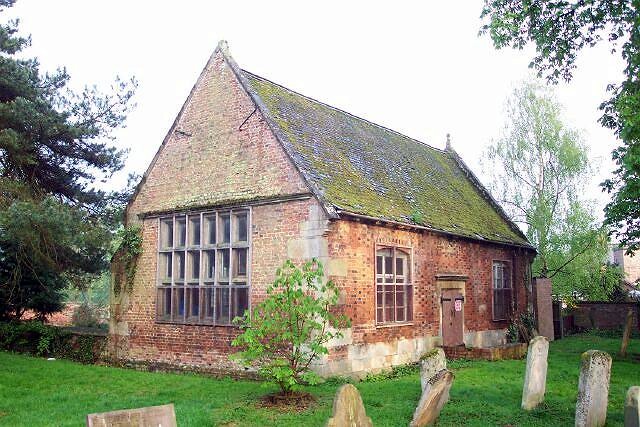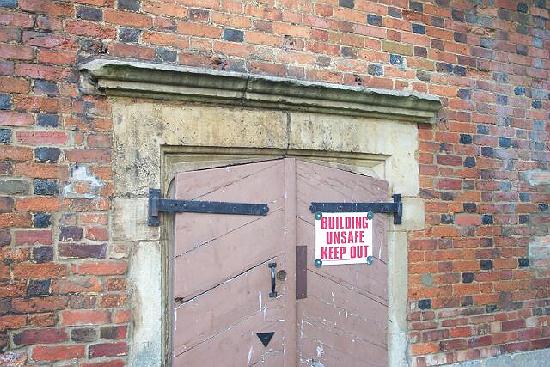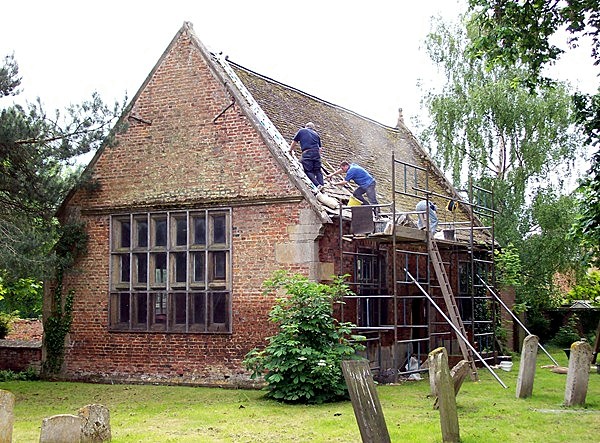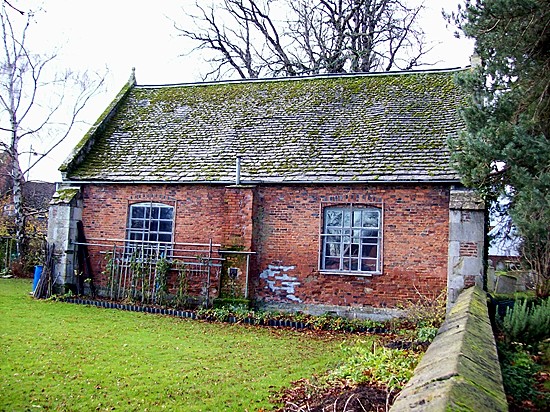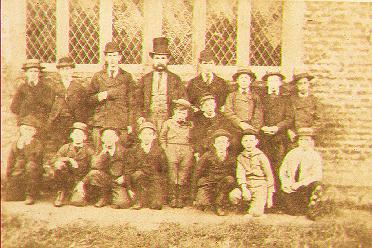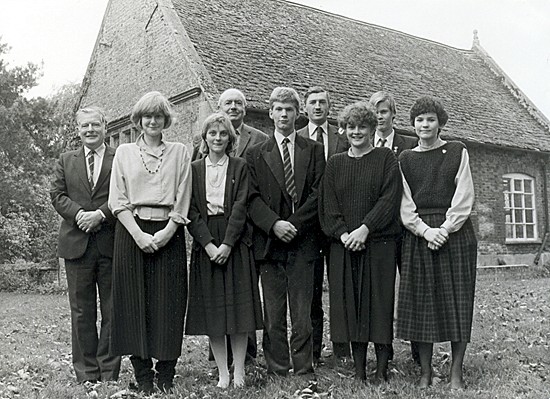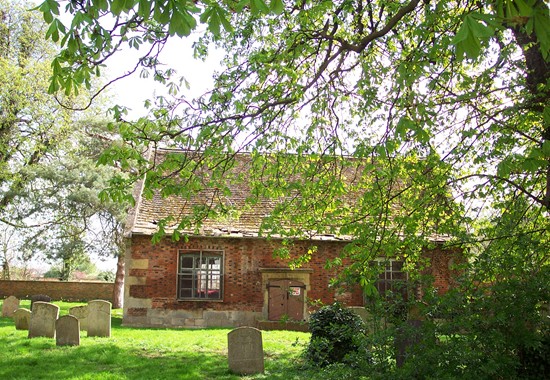|
The Old Grammar School
A grammar school has existed in Bourne since the Middle Ages and there are a number of references to the names of headmasters after 1580, either in the bishop's or the parish registers. One of these who was given permission to teach scholars within the parish of Bourne in 1625 was Edmund Lolley M A of Magdalene College, Oxford, who had already been Vicar of Bourne for 12 years. He died in 1632 and his will directed that his books and clothes should be sold for the benefit of his only son, also called Edmund, "to bring him up at the school". There was a rapid turnover in staff about this time and the names of seven different schoolmasters appear in the records during the first 30 years of the 17th century. Among them is Thomas Gibson who was appointed on 8th May 1629 and died a fortnight later on May 23rd but nevertheless received a tribute in the parish register saying that he was "as worthy a schoolmaster as ever taught in Bourne" and so he may have been engaged in some form of teaching in the town before being officially licensed by the bishop. A
new and important phase in the arrangements for education in Bourne began
in the early 17th century when William Trollope, a local landowner, left a bequest which provided for an endowment of £30 a year to maintain "an honest, learned, and godly schoolmaster" in a free grammar school incorporated by royal charter
and built by himself, most probably circa 1636. The school was sited next to the Abbey Church where
it still stands although the premises have been rebuilt since his day. His
will, dated 16th November 1636, stipulated that it should be called
"The Free Grammar School of King Charles in the town of Bourne and
County of Lincoln, of the foundation of William Trollope, gentleman". Lord Kesteven visited Bourne recently for the purpose of inspecting the grammar school. He decided on putting the building in thorough repair, and replacing the fittings with new desks, &c., of an improved pattern, some of the wood work, of massive oak, having been in use nearly 200 years. The alterations, which are now in progress, are to be completed by the end of the present vacation. The plot of ground belonging to the school, and adjoining it on the east, which has for many years been used as a garden, has had the fruit trees removed, the fish pond filled up and the ground levelled, and is now devoted to a playground for the scholars. The work was finished by the following year when the newspaper reported on Friday 19th January 1877: Through the liberality of Lord Kesteven, the Bourne Grammar School has been thoroughly repaired and various portions of the windows, &c., restored: new and improved desks and fittings have been introduced, the alterations having been successfully carried out under the superintendence of Mr Henry Osborn. The piece of ground east of the school, which had for several years been used as a garden, has been cleared and is used as a playground for the scholars. Five years later, a new stove chimney was erected and repairs carried out to the floor, dado boarding was fitted and when the ceiling was removed, the oak roof became visible. Today, it is a Grade II listed building within the Bourne conservation area, having been scheduled in July 1977 and the official description reads as follows: 1678. Single storey building in red and vitrified brick. Moulded stone plinth. Moulded stone cornice. Two buttresses on the west side. Tall brick chimney. Stone pinnacles to gable ends. Roof of old slates. South elevation has a repaired six-light mullioned window with two transoms and a stone cornice, extending across the whole building and damaged at one end. Side elevations have two 19th century windows, segmental arches in red and black brick. Door in centre of west side, with moulded stone, rectangular surround and moulded four-centred arch, at present hidden by a modern porch. The school appeared to have a more stable staff than in earlier years and in 1638, Exuperius Spencer RA was appointed schoolmaster and between then and the end of the century, there were only four successors. By the 19th century, the duties of schoolmaster were carried out by the vicars of Bourne until the Rev Joseph Dodsworth was appointed in 1842 when he delegated the actual work of teaching and administration to his curates until 1858 when William Webber was appointed under-master with a salary of £30 a year, as provided in the original endowment. Webber was an energetic and
conscientious teacher who pressed hard for improvements to the building
and it was his influence that provided the boys with a playground on a
small area of land adjoining the school on the east side. Scholars had
been playing in the churchyard among the tombstones and several had been
damaged and there had also been complaints about them roaming the streets
between lessons but the annual Vestry Meeting in April 1861 recommended
that this small strip of land in the ownership of the church be converted
for recreational use by the pupils. Webber was also probably responsible for the alterations of
1876 that included new seating to accommodate 32 boys, although he had
hoped that the facilities could have been extended to cope with 40. Many
of his pupils were successful in their studies, going on to Oxford and
Cambridge Universities, but he became frustrated with the slow response to
his repeated requests for improvements and he resigned in 1881 after 23
years of teaching and moved to a school at Tunbridge Wells. "We shall
be sorry to lose his services as he is a clever and genial man",
commented Mr Osborn, the agent for Sir John Trollope, in a letter to Lord
Kesteven. Despite his efforts, the future of the school was now in doubt and the 21 pupils in attendance in 1889 had dwindled to just nine by 1897 and soon it was removed from the list of those officially recognised by Kesteven District Council. Canham refused to accept the inevitable and in the autumn of 1903, he departed for Scarborough with the key of the school in his pocket but after much correspondence and discussion, he finally agreed to resign at the end of 1904, thus officially confirming the closure of the school. His later reminiscences gave an indication of life there in the final years for he said: "The boys, now men, who were with me in the eighties, have not forgotten how I used to join them in their games, to say nothing of supplying them with materials in the way of bats, balls etc and paying for broken windows." There were several attempts to revive the school in subsequent years, notably in 1910 when a local businessman and councillor, Mr Thomas Baxter, wrote to Lord Kesteven: "The old school wants a little attention, the roof is not rainproof, and the mischievous young Bournites have broken a good many panes of glass in the windows." But there was insufficient interest to give it a new lease of life and it stood empty and dilapidated until 1918 when the Charity Trustees handed it over to the church for their own use for a period of five years provided they were responsible for the necessary maintenance and repairs needed to keep the building in good order. The church decided to use it as a Sunday School and the formal opening took place on Tuesday 13th February 1918. The Stamford Mercury reported the following Friday: The room presented a cosy appearance. The Vicar, the Rev Harry Cotton Smith, presided at the ceremony and expressed thanks to those who had assisted in obtaining the necessary funds and carrying out the work of renovation. A grammar school meant teaching the best prose and poetry and no better prose or poetry could be imagined than the religion taught in a Sunday School. Mr J T Holmes, in formally declaring the room open, said the use to which it was proposed to devote the building was of the highest as he could conceive of no better object than the training of children in religious matters. Mr T M Baxter proposed a vote of thanks to Mr Holmes which was seconded by Mr C E Andrew and heartily accorded. After the opening ceremony, a lantern lecture was given by the Vicar, the subject being "Jerusalem". A collection was taken at the close of the lecture on behalf of the fund for the purchase of a new organ for the church. But the school was never re-opened for its original purpose and it was eventually replaced by a secondary school that became the present grammar school in 1921. Two years later, in January 1923, the school was sold by the trustees for a nominal sum of £100 to the secondary school and the board of governors has administered the building ever since. The building has largely been unused during that time although in the Second World War, the premises became an ambulance station and a meeting place for the Girl Guides and in later years it was used for a time as headquarters for the local troops of cubs and boy scouts.
The building is currently administered by the Bourne Educational Foundation but has again been badly neglected in recent years and in April 2003, it was condemned as unsafe and all entry forbidden. The roof was leaking and repairs were costed at £20,000. In February 2005, it was put up for sale at an undisclosed price, although potential buyers were warned that there is no vehicular access and the only approach is by way of a footpath through the churchyard. Nevertheless, sale to a private developer is seen as the only chance it has to survive.
REVISED JANUARY 2017
See also Vestry meetings Bourne Grammar School The Girl Guides
|
|||||||||||||||||||||||||||||||||||||||||||||||||||||||||||||
